Through his two-year SOURCE fellowship, Jaggena will work with both Professor Aaron Mohammed and Professor Todorova to study mercury contamination in waterways.
research
Mechanical and Aerospace Engineering Professor Changmin Shi Receives Grant for Solid-State Battery Research
Assistant Professor of Mechanical and Aerospace Engineering Changmin Shi has been awarded a three-year industry grant to develop a manufacturing system for solid electrolyte battery components.
Mechanical and Aerospace Engineering Professor Anupam Pandey Receives NSF Award for Adhesion of Patterned Films on Ultra-Soft Solids Research
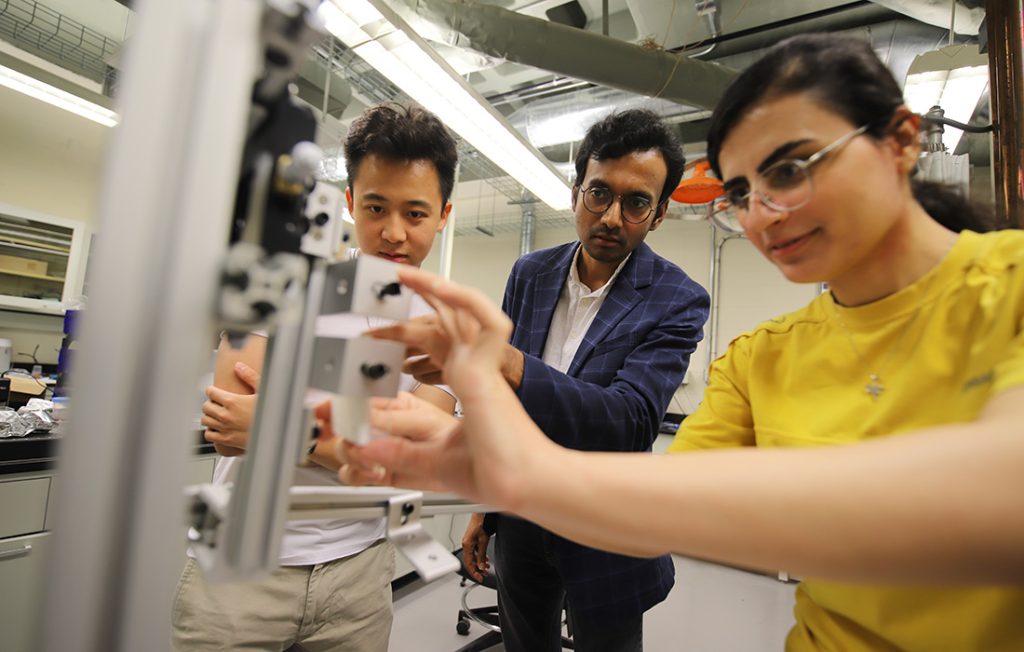
Mechanical and Aerospace Engineering Professor Anupam Pandey has received a National Science Foundation (NSF) grant to establish new strategies for controlling adhesion in ultra-soft and stretchable materials. His project will study how different types of materials stick together by examining thin materials that are partly attached to soft surfaces.
Small air pockets, or blisters, often form when surfaces don’t stick together properly, as seen in smartphone screen protectors or laminated materials. When these blisters are peeled away, one region may detach while another reattaches by itself in a unique transition described as peeling-to-rolling. This process causes noticeable changes in how strongly the surfaces stick together and involves complex interactions that existing methods can’t explain.
Pandey’s project will use analytical models and numerical simulations to understand how the peel-to-roll changes the way objects detach and causes sudden changes in the force needed to pull them apart. Additionally, the research will explore how the shape and arrangement of the air pockets can be engineered to actively control adhesion at the interface.
The findings aim to improve our understanding of how soft materials stick together in tight spaces and help design better soft interfaces for use in medical adhesives, flexible electronics, and soft robotics. To share this work, Pandey and his research team will host activities like a hands-on “Sticky Tapes” exhibit for kids, a summer workshop for high school students, and opportunities for undergraduates to get involved with research.
“This award gives us an exciting opportunity to uncover the mechanics of adhesion of blistered films on soft and stretchable materials,” says Pandey. “I’m eager to see how these insights will inspire both new science and practical applications.”
Biomedical and Chemical Engineering Student Paul Sagoe Selected as a 2024 Rostker Dissertation Fund Fellow
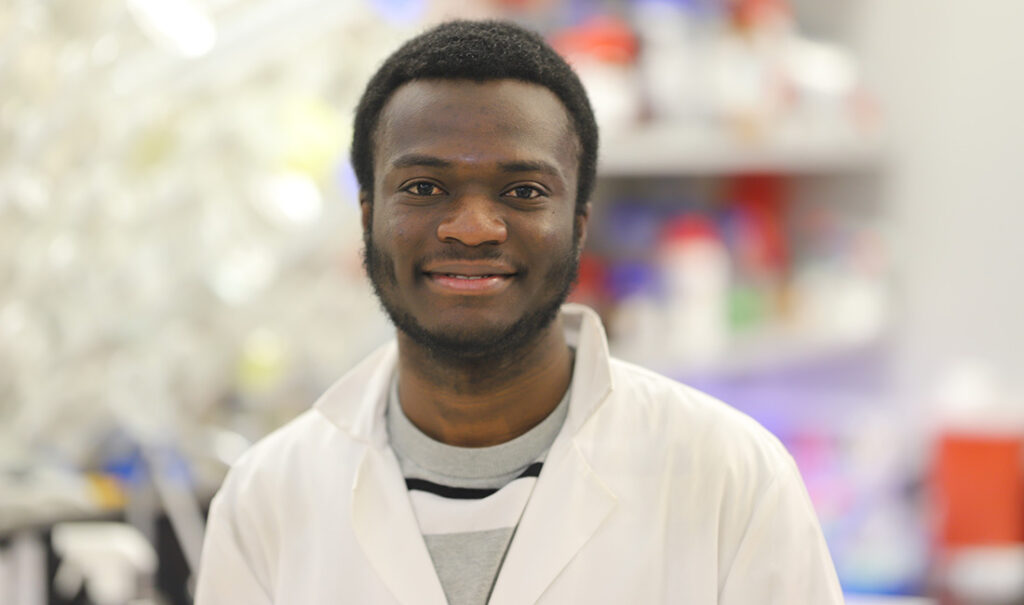
Managed by the D’Aniello Institute for Veterans and Military Families (IVMF), the Bernard D. and Louise C. Rostker IVMF Dissertation Research Fund recently provided more than $40,000 to four students who are at varying stages of their dissertation pursuits. The Rostker IVMF Dissertation Research Fund operates annually for a span of five years. This marks the second cycle of funding dedicated to supporting Ph.D. candidates conducting dissertation research on topics related to and in support of veterans and military families.
Paul Sagoe is a Ph.D. candidate in biomedical and chemical engineering. His research aims to develop a drug delivery system for treating post-traumatic osteoarthritis (PTOA) a painful joint condition common among veterans and military personnel.
Originally from Ghana, Sagoe came to Syracuse University after earning first class honors in biomedical engineering at the Kwame Nkrumah University of Science and Technology in Kumasi, Ghana. He also served as a clinical engineer at a teaching hospital in Ghana, an experience that invigorated his passion for medical science and informed his decision to pursue research studies in a field dedicated to impacting human health, improving patient’s well-being and alleviating pain. “As a Rostker Fellow, I am thrilled by the honor of being supported financially to pursue my research goals to the fullest capacity,” says Sagoe.
Sagoe’s dissertation, “Synovial Macrophage Targeting Immunomodulatory Therapies for Post-Traumatic Osteoarthritis,” aims to design a disease-modifying intervention for PTOA by selectively targeting and eliminating inflammation-promoting synovial macrophages. The strategy aligns with mounting evidence highlighting the crucial involvement of synovial inflammation in PTOA progression, a problem that impacts more than 30 million Americans suffering from osteoarthritis following a joint injury.
Bernard Rostker G’66, G’70, and Louise Rostker G’68 have spent years of dedicated effort supporting military families. Bernard himself is a U.S. Army veteran, and Louise has a devoted history of supporting education for military children and expanding employment opportunities for military spouses. The pair met while pursuing their own advanced degrees at Syracuse University, and make the funding available to support those students who may face insurmountable barriers in their pursuit to obtain higher education just as they did in the late 1960s and early 1970s.
“We both are so pleased with the program Syracuse University has established in our name,” says Bernard Rostker. “We know how demanding individual research can be, and we hoped that the support we could provide at a critical moment would have a positive impact. We look forward to the continued success of the program and the students it has helped.”
Flood Forecasting
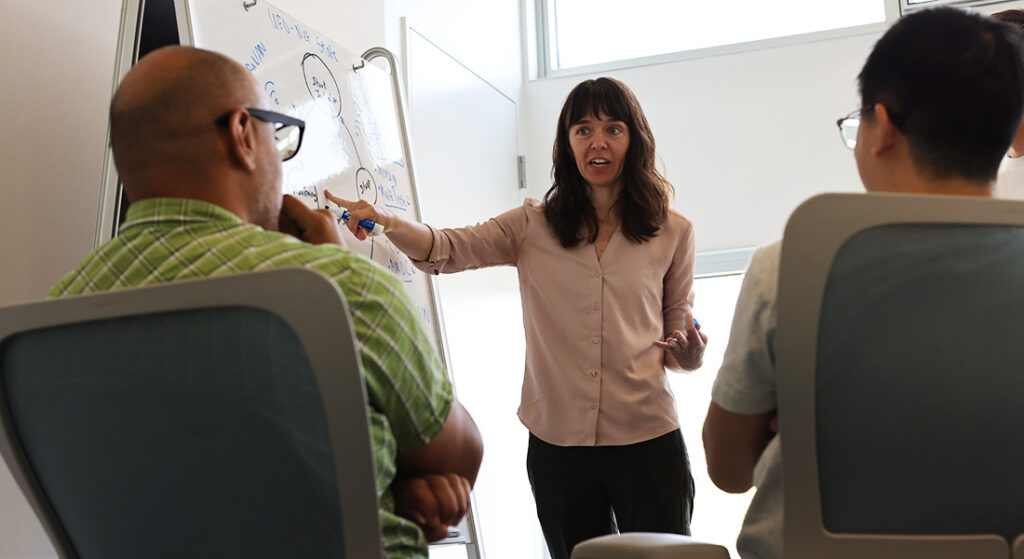
After Hurricane Katrina ravaged the southern coastline of the United States in 2005, Elizabeth Carter found herself on the Gulf Coast following the tropical storm’s aftermath. Witnessing the devastating impact of the hurricane on infrastructure and communities, she decided to place her undergraduate education on hold and join the efforts to rebuild – an experience that would be the catalyst for her future research.
“It was pivotal a time in U.S. history. It exposed a lot of the ways that structurally our publicly funded infrastructure is shunting risk down socioeconomic gradients,” Carter says. “As a young person figuring out what I wanted to do in the world, I didn’t think I could walk away from something like that and retain my humanity.”
Ignited with a passion for the environment, Carter returned to school and received her bachelor’s degree in soil science, a master’s in environmental information science and a Ph.D. in environmental engineering with a concentration in water resources. Now working as an assistant professor in civil and environmental engineering with a joint appointment as an assistant professor in earth and environmental sciences in the College of Arts and Sciences, Carter is a computational hydrologist who studies the movement of water from space. Using data from satellites, these observations of water movement allow her to develop ways to respond to natural disasters and manage water resources.
She and her research team at Syracuse University have received a water resource grant from the United States Geological Survey (USGS) to develop a sensor network that measures flooding. This sensor network will help predict different types of flooding caused by natural disasters, particularly flooding in areas where people live, which is referred to as urban flooding. This project is known as the Urban Flood Observing Network.
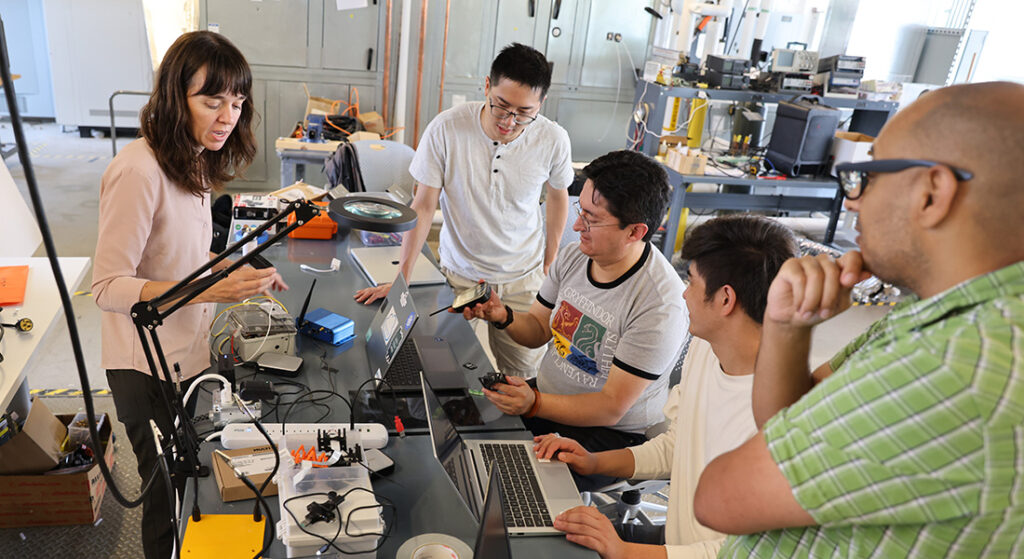
“We’re hoping to build a sensor network for better urban flood response and labels for satellite images so they can map urban flooding everywhere,” says Carter.
Fatemeh Rezaei G‘25 (environmental engineering), Huantao Ren G’21, Ph.D. ‘27 (computer science), Manu Shergill ‘24 (computer science) Nhy’ere Scanes, Ike Unobhaga, Kaitlyn Gilmore and Sharif Jafari are students from Syracuse University and Onondaga Community College (OCC) who have helped with the development of the Urban Flood Observing Network. Collaborators on the project include electrical engineering and computer science professor Senem Velipasalar and associate professor at the School of Information Studies, Carlos Caicedo.
“It’s been a great way to engage a lot of different students from different backgrounds and stages in their careers in hardware design, 3d printing, algorithm design, and photogrammetry,” says Carter.

Shergill is the primary developer leading the project and has been working on the sensor network since 2021. During a summer internship in his freshman year at OCC, he assembled the initial version of the water sensor camera. He’s also been working on adding higher-quality sensors, wireless communications, machine vision, and other features to the water sensor camera, hoping to install it on the roof of Syracuse’s Center of Excellence for testing.
“The next thing I’m tackling is a remote start function, so we can trigger continuous data collection when a storm is moving into the area the sensor is monitoring,” says Shergill.
Carter has hopes the USGS will install these sensor networks in different locations where quick responses to flood events are needed which can help manage future flood events.
“It’s been great to collaborate with different students on this project and make an impact on tackling natural disasters that are a result of climate change,” Carter says.
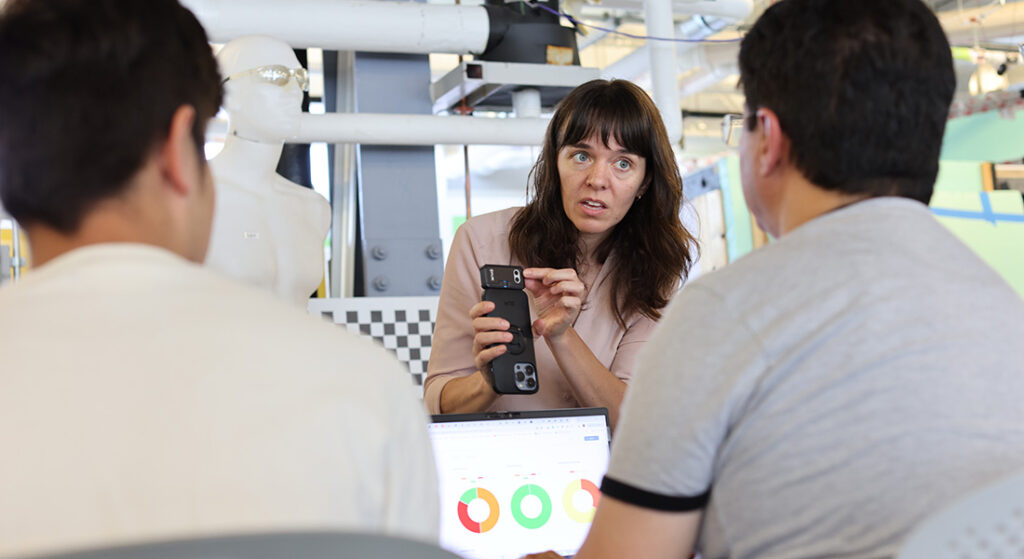
Mechanical and Aerospace Engineering Ph.D. Student Xuezheng Wang G’21 Awarded Rare ASHRAE Grant
Mechanical and aerospace engineering Ph.D. student Xuezheng Wang G’21 has been selected to receive an American Society of Heating and Air-Conditioning Engineers (ASHRAE) Graduate Student Grant-In-Aid for the 2024-2025 academic year.
Smart Speakers, Smarter Protection

Whether you’re looking to try a new recipe, dimming the lights in your living room, or curious about the species of bacteria living inside your mouth, Amazon Alexa has got you covered. With a simple voice command, Alexa’s ability to perform various tasks or answer questions has made it widely popular, with over 40 million users in the United States alone. Despite the convenience smart speakers like Alexa offer, these devices have also raised some privacy concerns.
Amazon has been known to collect data on users which includes their shopping habits, preferences, and even their location for personalized marketing. But that’s not all. When using waking words such as “Hey Alexa” to activate smart speakers, the audio of your voice command is also recorded and stored, becoming Amazon’s property. This means that Amazon owns your voice audio and can do whatever they want with it.
“Big tech companies are using our personal information. We’re less like customers and more like their product,” says graduate student Brian Testa ’24. “I’ve always been sensitive to that. I don’t use a lot of technology at home for that reason.”
Using voice data, companies like Amazon and Google have now developed technology that poses even more threats to privacy: AI and machine learning that can determine people’s emotional state or mood from their voice. This patented technology can even pick up on feelings from emotionally neutral phrases like “What’s the weather?” Since there are no laws in place to prevent this, there’s no protection against it.
“In the US for the last five to 10 years, lots of researchers have been working on how they can use voice to infer emotions, mood or even mental health,” says assistant professor in electrical engineering and computer science, Asif Salekin. “In my own lab, we have previous works on tech that can infer mental disorders like depression, social anxiety, manic disorder, and even suicidal tendencies from one’s voice.”
While this technology can be useful in certain circumstances, most users, if not all, have not consented to having their emotions detected by smart speakers. These privacy concerns led Testa, Professor Salekin, graduate students Harshit Sharma ’26 and Yi Xiao 26, and undergraduate student Avery Gump ’24 to begin researching ways to protect users’ privacy from smart speakers.
“Consent is key,” Salekin says. “We’d still like to use smart speakers since they’re quite useful – I have them in my own home. This project was about finding a way to use these devices without giving companies the power to exploit us.”
Led by Testa, the group conducted extensive research and developed a device that can be attached to a smart speaker or downloaded as software onto a laptop. This device emits a mild noise that only the smart speaker can hear and masks the emotional tone in your voice, providing a new level of privacy protection for concerned users.
“Through the use of a speech emotion recognition (SER) classifier, a smart speaker can analyze how people are feeling based on how they sound. We created a microphone device that listens for the wake word ‘Hey Alexa’”, Testa says. “When the smart speaker activates, our device activates too and begins to emit a noise that disrupts the smart speaker from detecting your emotions. However, only the smart speaker hears this noise.”
Currently, their device masks your emotional state by presenting it as a completely different emotion. When you speak, the smart speaker may detect from your voice that you’re sad, angry, or frustrated when you’re not feeling any of these emotions. This unpredictability makes it difficult for smart speakers to accurately determine your true emotions or mood and also prevents machine learning from picking up on any patterns and mood correlations. The group hopes to improve the device’s functionality by making it mask your emotions as neutral rather than presenting them as a different emotion.
“To create the mild noise our device emits, we utilized genetic programming to identify a combination of specific frequencies that disrupt the smart speaker from determining a person’s mood,” Salekin says. “Only the speaker hears this noise, but it can hear your speech commands clearly, so the utility of the smart speaker remains intact.”
Though the sound is only detected by the smart speaker, the group wanted to see how loud it would be when the device is used. Testa played the sound in the lab when Professor Salekin was having a meeting and Salekin didn’t even realize it was playing, which showed that the noise wasn’t disruptive. Additionally, they also conducted a survey with others to see if the noise was loud enough to be disruptive.
Testa, Salekin, Sharma, Xiao, and Gump are currently working on patent submissions, form factors, and speaking with companies about commercializing their device. What sets their patent apart from similar concepts is that while past technology focused on determining people’s moods or emotions, their technology is all about protecting them. This unique approach makes their device the first of its kind.
“It was a fun project,” Testa says. “This paper was published by me and as the first listed author, I’m excited about it. I’ve been working towards my Ph.D., and this is another step towards that goal.”
“Working with the students in real-world applications and research with real results was exciting,” Salekin says. “This research has many components and the collaboration between us was great. We’re excited to see what the future for this tech holds.”
Biomedical and Chemical Engineering Professor Radhakrishna Sureshkumar Awarded PRF Grant by American Chemical Society
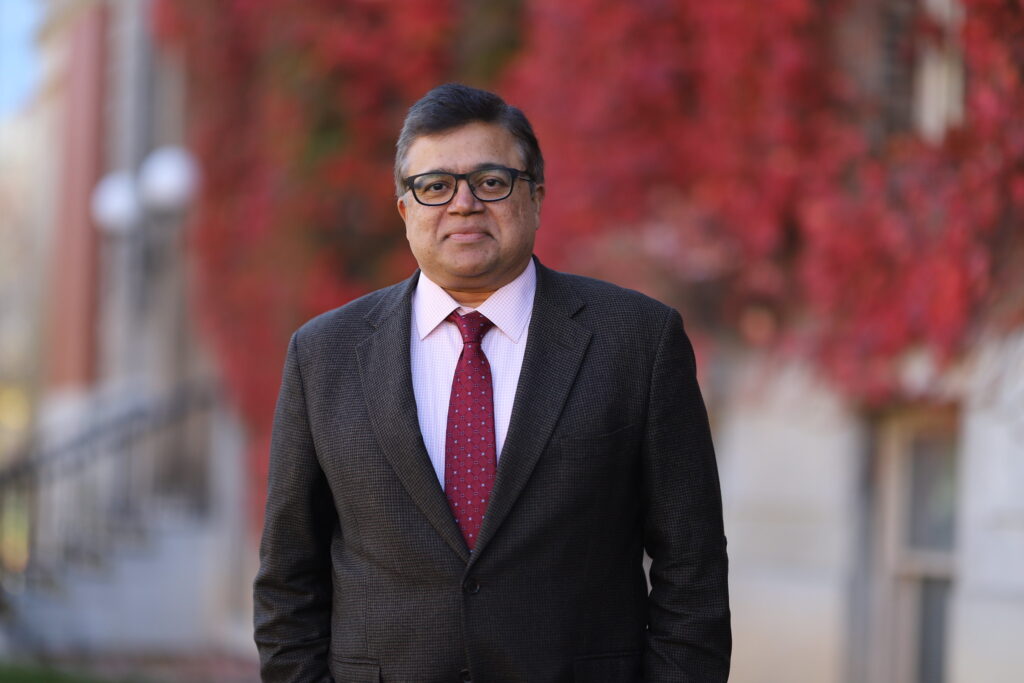
Extracting oil from the Earth in ways that minimize environmental harm is a challenging task. Methods like hydraulic fracturing require the injection of fluids into rock formations to create pressure for oil and natural gas to flow out. However, this process often causes air pollution and water contamination due to the use of toxic chemicals.
As researchers continue finding new ways to extract oil, distinguished professor in biomedical and chemical engineering, Radhakrishna (Suresh) Sureshkumar has made significant progress in research involving fluid mechanics and soft materials. Supported by the Petroleum Research Fund (PRF) from the American Chemical Society (ACS), he’s exploring the structure and flow behavior (rheology) of polymeric solutions that offer promise in efficient oil extraction.
“The ACS seeks to promote fundamental petroleum research and my research has received funding from the PRF in the past. They awarded me my very first grant during my tenure at Washington University and I’m looking forward to continuing research supported by the agency” says Sureshkumar.
With the fund, he and graduate student Senyuan Liu have been analyzing a group of molecules known as copolymers, which fall under the category of polymers, large molecules made of long, repeating chains of smaller molecules. Copolymers are made up of multiple polymers that possess different properties and are chemically bonded together. Most notably, copolymers consist of different blocks that have varying affinities to water. Some blocks are hydrophilic, meaning they like water and others are hydrophobic, which means they like oil.
Oil and water are known to not mix. However, there is a way they can be made compatible by using a substance called a surfactant. When a surfactant is added to water and oil, it creates an emulsion, the mixture of two or more liquids that don’t naturally mix. Using computational modeling, Sureshkumar and Liu are exploring the thermodynamic patterns underlying the assembly of copolymers in aqueous solutions. Further, they are investigating how molecular assemblies deform under flow conditions.
“Detergent is a good example of a surfactant. Dirt is oil-like material and when washing clothes, you add detergent to the washing machine because oil and water are not thermodynamically compatible,” Sureshkumar explains. “A surfactant has two parts to its molecular structure: one part is hydrophilic, the other is hydrophobic. So, when water, oil, and detergent are put together, it creates an emulsion allowing water and oil to mix.”
He and Liu have also been studying how copolymers self-assemble into various shapes such as spheres, cylinders, disks, and vesicles when they’re in water. Since copolymers possess different properties, some being hydrophilic and some hydrophobic, the oil-loving molecules avoid contact with water, leading to self-assembly and the formation of different shapes.
To further explore fluid dynamics, Sureshkumar and Liu have now developed technology that uses molecular dynamics simulations to study self-assembling molecules and their applications in oil extraction. They experiment with how these shapes self-assemble in different environments and have recently published a paper about their work.
“The molecular simulation we’ve created contains water and we can adjust the temperature and pressure as well. Adding individual polymer molecules, moving them around and tracking the process allows us to see how the invisible hand of thermodynamics causes them to self-assemble into various shapes,” Sureshkumar says. “We can see how these types of polymers will react in a natural environment, an engineered environment, or even the human body using this simulation.”
Studying how structures organize into different shapes and the thermodynamic mechanisms behind the creation of polymer structures is crucial, according to Sureshkumar. This research enables new ways to understand how to extract petroleum from the Earth and he believes the oil and natural gas industry can benefit from numerous applications of this research. It can also help unravel the mysteries of nature and answer questions regarding what causes polymers to self-assemble in the first place.
“Why would nature take a bunch of molecules and assemble them into a particular shape? This is a fundamental question,” he says. “Gaining an understanding of how nature creates nanostructures, we can engineer nanoscopic assemblies of molecules in a smart way and design better technologies to benefit society. The current grant from the Petroleum Research Fund helps us continue such fundamental explorations.”
Electrical Engineering and Computer Science Professor Bryan S. Kim Receives Funding for Rack Scale Computing Research
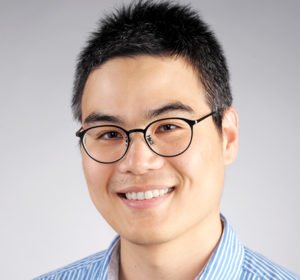
Bryan S. Kim, assistant professor in electrical engineering and computer science, has received funding from semiconductor company FADU to explore how CXL, a new open standard for connecting computer components, would transform data center applications.
With CXL, an entire rack of computers can be connected through the peripheral component interconnect express (PCIe) bus with shared memory coherency, rethinking how computers access and share data.
“CXL is still in its infancy with only limited publicly available hardware. After all, its specification is only a few years old” Kim explained. “Furthermore, how CXL and its hardware would affect software system design is completely unexplored.”
Kim’s collaborative project will investigate the fundamental technologies for building a software system with CXL memory, the designs for resilient and reliable CXL fabric, and the transformation of data center applications due to CXL.
“While there is a large research community interest in CXL, there are only a handful of research groups who have published in this area,” Kim said. “I am grateful to be at the leading front and continuing the success of this project.”
Civil and Environmental Engineering Professor Charles Driscoll Selected for the 2023 Clarke Prize in Water Science

Civil and Environmental Engineering Professor Charles Driscoll has been selected to receive the 2023 Athalie Richardson Irvine Clarke Prize for Outstanding Achievement in Water Science and Technology from the National Water Research Institute. Driscoll is the University and Distinguished Professor of Environmental Systems Engineering in College of Engineering and Computer Science.
The Clarke Prize is considered one of the most prestigious awards pertaining to water science. It is awarded to thought leaders in water research, science, technology, or policy in the United States. Past honorees have included some of the most significant figures in civil and environmental engineering; the water, biological, physical, chemical, health, and political sciences; and public planning and policy.
Driscoll’s research largely involves characterization and quantifying the impacts of air pollution, such as acid rain and mercury, changing climate, and land and water disturbances on the structure and function of ecosystems, and pathways of ecosystem recovery. Much of his work has focused on forests and associated aquatic resources, including long-term studies at the Hubbard Brook Experimental Forest, NH and the Huntington Forest in the Adirondacks, NY. Recent work has included strategies for the decarbonization of sectors and achieving net zero greenhouse gas emissions.
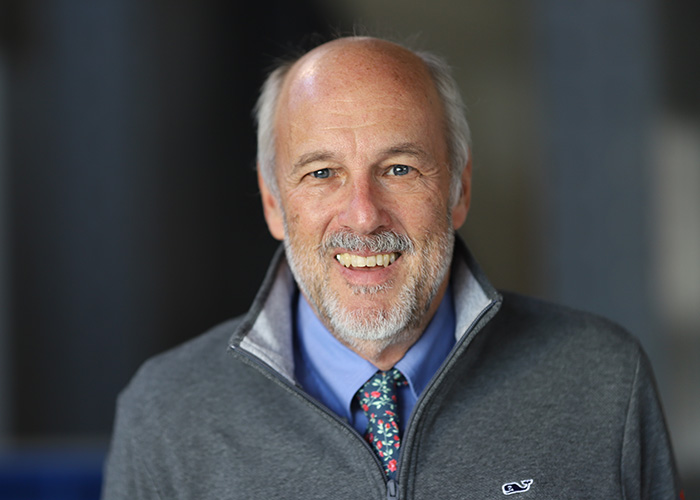
Over the past 40 years, Driscoll has advanced new analytical techniques, established and maintained long-term measurements and experiments, and developed a series of research and predictive models that simulate transformations of major chemical elements in forest vegetation, soil and surface waters in response to air pollution, climate and land disturbance. Beyond theory, he is interested in testing ‘in situ’ strategies to reverse the damaging effects of acid rain and mercury contamination, eutrophication, urbanization, and climate change. Driscoll has testified at US Congressional and state legislative committee hearings, and provided briefings to government agencies, industry and stakeholder groups on environmental issues. He has served on local, national and international committees pertaining to environmental management and policy.
Driscoll will receive the award and give a lecture in Irvine, California, on October 21, 2023. For information about attending the event, fill out the form on the Clarke Prize page.
Electrical Engineering and Computer Science Professor Yuzhe Tang Receives Grant to Protect Ethereum Security

Yuzhe Tang, associate professor of electrical engineering and computer science in the College of Engineering and Computer Science, and his research team have been awarded a grant by the Ethereum Foundation for research to advance the Ethereum blockchain ecosystem. This grant will support Tang and his Ph.D. students in designing, developing, and evaluating the security hardening code to protect the Ethereum network stack.
Ethereum is a network made up of several communities and toolsets that allow users to communicate or make transactions with digital money. Since the network is decentralized, users are in complete control of their data and what’s being shared, so they don’t need to give up any personal information – all users need to access Ethereum is an internet connection.
Denial of service security is critically important to the Ethereum blockchain ecosystem, and the research will explore ways to protect the Ethereum network from cyberattacks, involving systematic vulnerability discovery using applied formal methods. As cyber criminals attack networks like Ethereum and security concerns grow, Tang believes this research could have a lasting impact on the current landscape of cybersecurity and blockchain platforms.
“With this grant, we can help solve some of the most critical problems in the real world. We expect to continue developing code merged into Ethereum codebase,” Tang says. “I am most excited about making real-world impacts out of the research works from my group.”
Researchers’ Artificial Intelligence-Based Speech Sound Therapy Software Wins $2.5M NIH Grant

Three Syracuse University researchers, supported by a recent $2.5 million grant from the National Institutes of Health, are working to refine a clinically intuitive automated system that may improve treatment for speech sound disorders while alleviating the impact of a worldwide shortage of speech-language clinicians.
The project, “Intensive Speech Motor Chaining Treatment and Artificial Intelligence Integration for Residual Speech Sound Disorders,” is funded for five years. Jonathan Preston, associate professor of communication sciences and disorders, is principal investigator. Preston is the inventor of Speech Motor Chaining, a treatment approach for individuals with speech sound disorders. Co-principal investigators are Asif Salekin, assistant professor of electrical engineering and computer science, whose expertise is creating interpretable and fair human-centric artificial intelligence-based systems, and Nina Benway, a recent graduate of the communication sciences and disorders/speech-language pathology doctoral program.
Their system uses the evidence-based Speech Motor Chaining software, an extensive library of speech sounds and artificial intelligence to “think” and “hear” the way a speech-language clinician does.
The project focuses on the most effective scheduling of Speech Motor Chaining sessions for children with speech sound disorders and also examines whether artificial intelligence can enhance Speech Motor Chaining—a topic Benway explored in her dissertation. The work is a collaboration between Salekin’s Laboratory for Ubiquitous and Intelligent Sensing in the College of Engineering and Computer Science and Preston’s Speech Production Lab in the College of Arts and Sciences.
Clinical Need
In speech therapy, learners usually meet with a clinician one-on-one to practice speech sounds and receive feedback. If the artificial intelligence version of Speech Motor Chaining (“ChainingAI”) accurately replicates a clinician’s judgment, it could help learners get high-quality practice on their own between clinician sessions. That could help them achieve the intensity of practice that best helps overcome a speech disorder.
The software is meant to supplement, not replace, the work of speech clinicians. “We know that speech therapy works, but there’s a larger issue about whether learners are getting the intensity of services that best supports speech learning,” Benway says. “This project looks at whether AI-assisted speech therapy can increase the intensity of services through at-home practice between sessions with a human clinician. The speech clinician is still in charge, providing oversight, critical assessment and training the software on which sounds to say are correct or not; the software is simply a tool in the overall arc of clinician-led treatment.”
170,000 Sounds
A library of 170,000 correctly and incorrectly pronounced “r” sounds was used to train the system. The recorded sounds were made by 400-plus children over 10 years, collected by researchers at Syracuse, Montclair and New York Universities, and filed at the Speech Production Lab.
Benway wrote ChainingAI’s patent-pending speech analysis and machine learning operating code, which converts audio from speech sounds into recognizable numeric patterns. The system was taught to predict which patterns represent “correct” or “incorrect” speech. Predictions can be customized to individuals’ speech patterns.
During speech practice, the code works in real time with Preston’s Speech Motor Chaining website to sense, sort and interpret patterns in speech audio to “hear” whether a sound is made correctly. The software provides audio feedback (announcing “correct” or “not quite”), offers tongue-position reminders and tongue-shape animations to reinforce proper pronunciation, then selects the next practice word based on whether or not the child is ready to increase word difficulty.
Early Promise
The system shows greater potential than prior systems that have been developed to detect speech sound errors, according to the researchers.
Until now, Preston says, automated systems have not been accurate enough to provide much clinical value. This study overcomes issues that hindered previous efforts: Its example residual speech sound disorder audio dataset is larger; it more accurately recognizes incorrect sounds; and clinical trials are assessing therapeutic benefit.
“There has not been a clinical therapy system that has explicitly used AI machine learning to recognize correct and distorted “r” sounds for learners with residual speech sound disorders,” Preston says. “The data collected so far shows this system is performing well in relation to what a human clinician would say in the same circumstances and that learners are improving speech sounds after using ChainingAI.”
So Far, Just ‘R’
The experiment is currently focused on the “r” sound, the most common speech error persisting into adolescence and adulthood, and only on American English. Eventually, the researchers hope to expand software functionality to “s” and “z” sounds, different English dialects and other languages.
Ethical AI
The researchers have considered ethical aspects of AI throughout the initiative. “We’ve made sure that ethical oversight was built into this system to assure fairness in the assessments the software makes,” Salekin says. “In its learning process, the model has been taught to adjust for age and sex of clients to make sure it performs fairly regardless of those factors.” Future refinements will adjust for race and ethnicity.
The team is also assessing appropriate candidates for the therapy and whether different scheduling of therapy visits (such as a boot camp experience) might help learners progress more quickly than longer-term intermittent sessions.
Ultimately, the researchers hope the software provides sound-practice sessions that are effective, accessible and of sufficient intensity to allow ChainingAI to routinely supplement in-person clinician practice time. Once expanded to include “s” and “z” sounds, the system would address 90% of residual speech sound disorders and could benefit many thousands of the estimated six million Americans who are impacted by these disorders.
Written by Diane Stirling
Electrical Engineering and Computer Science Professor Senem Velipasalar Awarded Patent for Room Occupancy Detection Platform
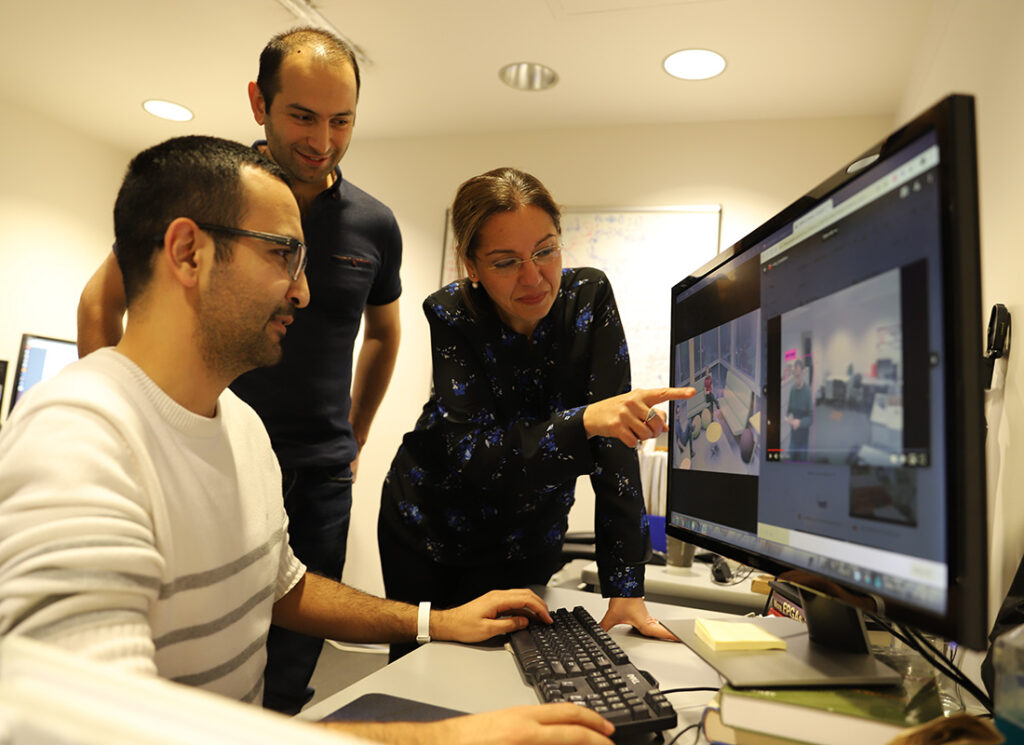
Remembering to turn the lights off when leaving a room is easy, but letting the furnace that you’re headed out isn’t as simple. About 37% of all energy used by commercial buildings and 40% of energy used in residences go toward heating, ventilation, and air conditioning (HVAC). The costs related to heating and cooling unoccupied spaces in homes and office buildings have been a challenge for decades.
Current occupancy sensors only detect movement, so they can’t tell if someone is stationary. They also have trouble distinguishing between people and large pets, and often require an external power source and data processing. When a room is occupied, not being able to detect occupancy can cause user discomfort. On the other hand, not reliably knowing when a room is empty adds up to massive amounts of unnecessary heating and cooling costs for spaces without any people in them.
A collaboration between Electrical Engineering and Computer Science Professors Senem Velipasalar and Pramod Varshney, Mechanical and Aerospace Engineering Professor Ed Bogucz, Professor Tarek Rakha from Georgia Tech and SRI International, a nonprofit research institute, has developed a new sensor platform, MicroCam, which addresses many of the limitations that current systems face. Their project received funding from the U.S. Department of Energy’s Advanced Research Projects Agency – Energy (ARPA-E) and had to meet certain requirements. The platform had to be highly accurate, low-maintenance, affordable and easily self-commissioned for consumers while still providing more than 30% energy savings.
“It was important to us and ARPA-E that this platform be highly reliable, practical and inexpensive,” says Velipasalar. “This needed to be useful in real-world spaces, and it was designed to be battery-powered.”
The MicroCam is equipped with multi-modal sensors that can process motion, audio and video data. The camera can operate under daylight, low light or even no light conditions and it can be powered for more than a year on just three AA batteries – all the sensor processing is done inside one small unit.
“We do not use cloud computing, everything is captured and processed on this platform,” says Velipasalar. “You are not transferring or saving data, so it alleviates privacy concerns.”
While the MicroCam can detect occupancy, it does not share potentially private information.
“It senses your presence but only sends a 0 or 1 signal to the HVAC system,” says Velipasalar. “That binary occupancy result is the only data shared with the lead platform.”
Industrial and Interactive Design Professor Don Carr and his students worked with Velipasalar and Bogucz to design a prototype case for the MicroCam.
“Eventually we want a peel and stick and ideally you want to install one per room,” says Velipasalar. “If you have one of these in each room, you could monitor the entire space.”
Velipasalar was granted a patent in March 2023 titled “Low Power and Privacy Preserving Sensor Platform for Occupancy Detection.” It is the sixth patent she has been awarded over her career.
“This was a challenging project. We had to meet low cost and high accuracy requirements but it has incredible potential,” says Velipasalar.
The platform may have additional uses in the future including smart home integration and security monitoring. Velipasalar also sees possibilities for the MicroCam to provide activity monitoring and fall detection for families and nursing homes.
Mechanical Engineering Student Ruohan Xu Receives Norma Slepecky Research Prize
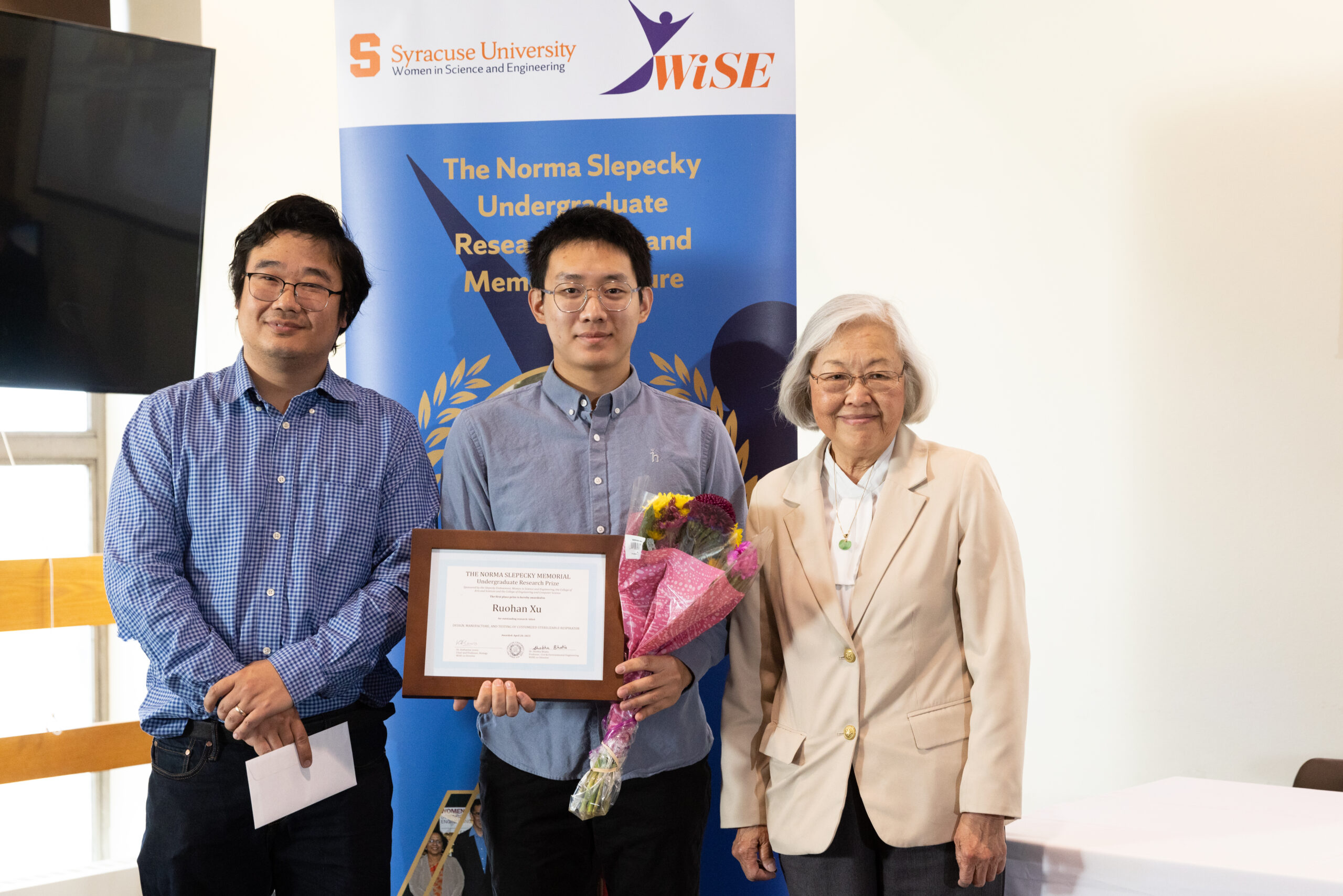
Recent mechanical engineering and applied mathematics graduate, Ruohan Xu ’23, G ’24, has received the Norma Slepecky Undergraduate Prize for his research activities. Xu received the award from the Women in Science and Engineering Review Committee and was nominated by his advisor, Civil and Environmental Professor, Zhao Qin.
In memory of the late auditory neuroanatomist and Syracuse University professor, Norma Slepecky, this award is given to a student who demonstrates a passion for research. Xu’s continued contributions to ECS embody Slepecky’s ambitious spirit and uphold her legacy as a pioneer in bioengineering.
In his first research project, Xu focused on enhancing mask design through image-based surface morphing, and his findings were published in the Journal of the Mechanical Behavior of Biomedical Materials in 2022. His second project saw him focus on the growing environment of mycelium composites for the application to infrastructure.
With two research projects and a journal publication under his belt, Xu is also an active member of his college community, currently serving as the President of the Chinese Union Syracuse and former Vice President of the Syracuse University Robotics Club. Xu is continuing his studies at Syracuse University, working towards a master’s degree in civil and environmental engineering.
Learning Through Research: Hennecys Perez Castro ’25

Hennecys Perez Castro is a sophomore environmental engineering major from the Bronx, NY. In her short time at the College of Engineering and Computer Science (ECS), Hennecys has participated in the Air Force ROTC program, a Marine officer program, she is an active member of the Society of Hispanic Professional Engineers (SHPE), and she is doing paid research relevant to her field of study.
“Doing research creates a great baseline to explore what you want to do. Being at an R1 university means there is a lot of funding and that opens up a lot of opportunity,” says Hennecys.
Hennecys learned about research opportunities through ECS Laboratory Manager and SHPE advisor Mario Montesdeoca. He helped her get started as a trainee in the environmental engineering labs as a first-year student. It gave her an opportunity to ask questions and learn how to apply for a Research Experience for Undergraduates.
Hennecys’ first research project involved measuring CO2 and O2 concentrations from different soil depths to explore soil respiration response and testing new low-cost CO2 sensor technology. During the fall semester of her sophomore year, she presented her research at the Long-Term Ecological Research All Scientists Meeting in California and took second place in a poster competition.
In addition to her ongoing CO2 censor testing, Hennecys is facilitating a lab project under University Professor of Environmental Systems and Distinguished Professor Charles Driscoll. The project involves conducting a sediment core analysis on samples collected from Skaneateles Lake just west of Syracuse. The research is a continuation of a larger project aimed at determining how the lake sediment is evolving due to the environment. Currently, Hennecys and her lab partner Oliver Raycroft are prepping the samples for chemical extraction. Once extracted, they will begin a data analysis to determine the effects of algae blooms, marine life viability, and to measure phosphorus concentration.
“The samples in the sediment cores tell a story. This research is small part of a bigger story,” says Hennecys. “The overall goal is important because this is information people need and can use.”
Research has helped Hennecys build a network and skillsets that will be important for her career development. It’s just one example of how she is utilizing resources available through ECS to prepare for her future. She says the support she has received through the ECS Office of Inclusive Excellence and SHPE, along with participation in several Syracuse University student leadership programs has augmented her education.
“Taking about my research has taught me how to present to a non-engineering audience. Overall, research is helping me learn skills I need to incorporate as I look forward to my career,” says Hennecys. “In addition to being a peer leader and an orientation leader, research helps me connect with others and build my confidence for post-graduation.”
Funding for Hennecys’ research is provided by Collegiate Science and Technology Entry Program, Louis Stokes Alliance for Minority Participation Program, the National Aeronautics and Space Administration (NASA), and the The Syracuse Office of Undergraduate Research and Creative Engagement.
2023 Engineering and Computer Science Research Day Award Winners Announced

2023 ECS Research Day Awards
Oral Presentations
Communications and Security
First Place: Carlos Espinoza Zelaya. Enhancing the operational resilience of Cyber-manufacturing Systems (CMS) against cyber-attacks. Advisor: Dr. Young Moon
Second Place: Kyungrok Won. Bring Your Own Ethereum Network (Proof-of-Stake). Advisor: Dr. Wenliang Du
Energy, Environment & Smart Materials
First Place: Alexander Hartwell. Ceramic Origami: Utilizing Bilayer Shrinkage to Form Intricate 3D Ceramic Objects. Advisor: Dr. Jeongmin Ahn
Second Place: Johnson Agyapong. Surface Functionalization of 4D Printed Substrates Using Polymeric and Metallic Wrinkles. Advisor: Dr. James Henderson
Health and Well-Being
First Place: Maryam Ramezani. Enzymatically-Responsive Shape Memory Polymers for Chronic Wound Infection Surveillance and Biofilm Prevention. Advisor: Dr. Mary Beth Monroe
Second Place: Yikang Xu. Micron-scale topographies affect phagocytosis of bacterial cells on polydimethylsiloxane. Advisor: Dr. Dacheng Ren
Sensors, Robotics & Smart Systems
First Place: Shao-Peng Yang. Overcoming the Memory Wall with CXL-Enabled SSDs. Advisor: Dr. Bryan Kim
Second Place: Akib Jawad Nafis. VETIOT: On Vetting IoT Defenses Enforcing Policies at Runtime. Advisor: Dr. Endadul Hoque
POSTER PRESENTATIONS
First Place: Romesh Prasad. Reinforcement learning agent based cyber-manufacturing systems recovery Faculty advisor: Dr. Young Moon
Second Place (tie): Paul Sagoe. Fabrication of Nanoparticles loaded Microparticles for Sustain and Target Delivery of Zoledronate to Activated Macrophages for the Modulation of Inflammation in Osteoarthritis. Faculty advisor: Dr. Era Jain
Second Place (tie): Arick Grootveld. Reinforcement Learning based Resource Allocation for Radar Scanning and Multi-target Tracking. Faculty advisor: Dr. Venkata Gandikota
Honorable Mention: Cheng Lyu. Poster number: The Impacts of Dynamic Line Rating on Systems with High Levels of Renewable Energy Resources. Faculty advisor: Dr. Sara Eftekharnejad
Acknowledgements:
Oral Presentation Co-Chairs
| Dr. Victor Duenas (ECS) Dr. Sara Eftekharnejad (ECS) Dr. Natarajan Gautam (ECS) | Dr. Anupam Pandey (ECS) Dr. Younes Ra’di (ECS) | Dr. Ted Walker (ECS) Dr. Teng Zeng (ECS) Dr. Yi Zheng (ECS) |
Poster Session Judges
| Dr. Riyad S Aboutaha (ECS) Dr. Ali Bahrami (Fulton) Dr. Michael Birnkrant (Carrier) Dr. Biao Chen (ECS) Dr. Ruth Chen (ECS) Dr. Bing Dong (ECS) Dr. Eric Finkelstein (ECS) Dr. Zhenyu Gan (ECS) Dr. Nadeem Ghani (ECS) Dr. Endadul Hoque (ECS) | Dr. Bryan Kim (ECS) Dr. Fanxin Kong (ECS) Dr. Xiyuan Liu (ECS) Dr. Jean-Daniel Medjo Me Biomo (ECS) Dr. Joao Paulo Marum (ECS) Dr. Kris Micinski (ECS) Dr. Mary Beth Monroe (ECS) Dr. Igor Mrdjen (BloomOptix) Dr. Ozioma F Nwabor (ECS) Dr. Baris Salman (ECS) Dr. Ashok Sangani (ECS) | Dr. Cynthia Smith (ECS) Dr. Yiyang Sun (ECS) Dr. Christopher M Thomas (Chimera Bioworks) Dr. Pierre Wellner (airCoda) Dr. Guangchao Wan (ECS) Dr. Garret Katz (ECS) Dr. Yeqing Wang (ECS) Dr. Yaoying Wu (ECS) Dr. Reza Zafarani (ECS) |
Poster Session Co-Chairs
| Dr. Zhao Qin (ECS) | Dr. Senem Velipasalar (ECS) |
Engineered Magic: Wooden Seed Carriers Mimic the Behavior of Self-Burying Seeds

Before a seed can grow into a tree, flower or plant, it needs to successfully implant itself in soil – a delicate and complex process. Seeds need to be able to take root and then remain protected from hungry birds and harsh environmental conditions. For the Erodium flower to implant a seed, its stalk forms a tightly wound, seed-carrying body with a long, curved tail at the top. When it begins to unwind, the twisting tail engages with the ground, causing the seed carrier to push itself upright. Further unwinding creates torque to drill down into the ground, burying the seed.
Inspired by Erodium’s magic, Mechanical and Aerospace Engineering Professor Teng Zhang worked with Lining Yao from Carnegie Mellon University (CMU) and a team of collaborators to engineer a biodegradable seed carrier referred to as E-seed. Their seed carrier, fashioned from wood veneer, could enable aerial seeding of difficult-to-access areas, and could be used for a variety of seeds or fertilizers and adapted to many different environments. The carriers also could be used to implant sensors for environmental monitoring. They might also assist in energy harvesting by implanting devices that create current based on temperature fluctuations.

“This is a perfect example demonstrating the beauty and power of bioinspired design. We learn from nature and eventually achieve superior performance by leveraging the freedom of engineering design,” said Zhang, who also serves as an executive committee member of the Bioinspired Institute.
The team’s research appeared in the February issue of Nature.
The project is led by Lining Yao, director of the Morphing Matter Lab in the School of Computer Science’s Human-Computer Interaction Institute at CMU. Zhang developed models and performed simulations to explain the working mechanism of the wood actuators and the benefits of E-seed design. The key authors of the paper also include Danli Luo, a former research assistant at the Morphing Matter Lab, Shu Yang, a materials scientist from the University of Pennsylvania, Guanyun Wang, a former postdoctoral researcher in the Morphing Matter Lab and now a faculty member at Zhejiang University, and Aditi Maheshwari and Andreea Danielescu from Accenture Labs.
“Seed burial has been heavily studied for decades in terms of mechanics, physics and materials science, but until now, no one has created an engineering equivalent,” said Yao. “The seed carrier research has been particularly rewarding because of its potential social impact. We get excited about things that could have a beneficial effect on nature.”
“Gaining insight into the mechanics of wood and seed drilling dynamics leads to improved design and optimization,” said Zhang. “I am excited to see, by embracing cross-disciplinary collaborations, mechanics can play a critical role in making our society more sustainable.”
Read more about this collaborative project.
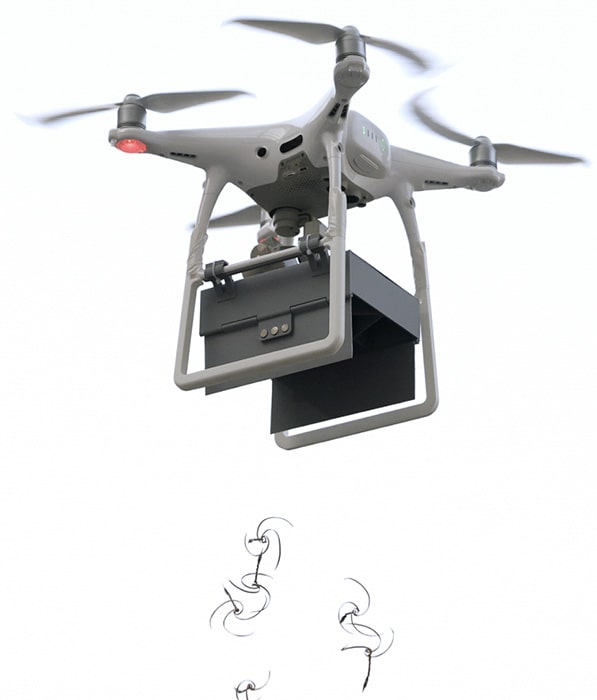
(Written by Byron Spice and Alex Dunbar)
Avocado Power
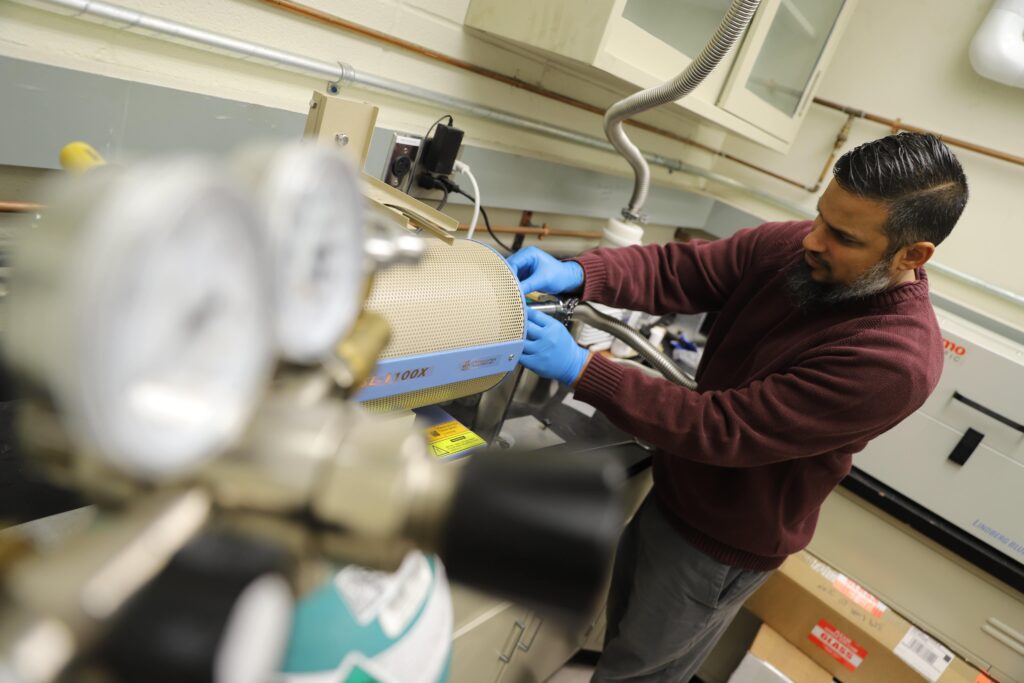
The high demand for lithium-ion batteries has triggered significant research interest in finding alternative ion carriers. In a recent publication, Biomedical and Chemical Engineering Professor Ian Hosein’s research team showed how they produced high performance hard carbon from avocado peels using high temperature processing. Electrochemical measurements confirmed the use of avocado-derived hard carbon as electrode active materials, with high reversible capacities of 320 mAh g−1 over 50 cycles at 50 mA g−1, good rate performance of 86 mAh g−1 at 3500 mA g−1, and Coulombic efficiencies above 99.9% after 500 cycles.

“We see avocado carbon as a cost effective and abundant source that yields a promising anode material for high-rate performance sodium-ion batteries,” says Hosein.
The research was supported by a grant from the National Science Foundation. Doctoral students Francielli Silva Genier, Shreyas Pathreeker, Robson Luis Schuarca and Dr. Mohammad Islam collaborated with Hosein on the research and publication in the IOPscience journal.

Rolling Right Off
New research from Syracuse University shows how nanochannels, oil and candle soot could provide a water repelling surface with numerous applications.
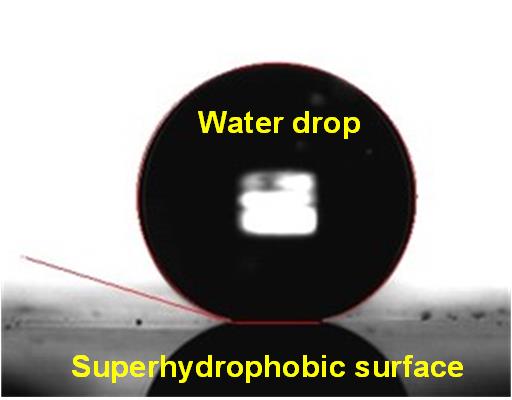
Surfaces that allow water or other liquids to roll right off are uniquely present in nature, such as on lotus leaves as well as on few aquatic insects, enabling them to walk on water or breathe under water by trapping a layer of air on their bodies. Such superhydrophobic surfaces can be helpful in a variety of engineering applications, ranging from coating of windshields and surgical tools, to steam turbines and condensers in power plants, and to improved hydrodynamics of submarines and ships.
Despite advancements in the development of artificially engineered superhydrophobic surfaces, durability and regenerative aspects of such surfaces remain elusive. Harsh working conditions including extreme exposure to water or humidity can deteriorate such surfaces especially after extended under-water usage.
Mechanical and aerospace engineering doctoral student Durgesh Ranjan and Professor Shalabh C. Maroo have developed a new approach for creating a durable superhydrophobic surface by first plasma-treating a fabricated porous nanochannel geometry on a silicon substrate followed by infusion-depletion of silicon oil and coating a layer of carbon derived from candle soot.
“We are able to engineer a superhydrophobic surface which is durable against high-speed water jets, non-sticky to many liquids ranging from water to honey, and stable under water for months,” says Maroo.
Research from Ranjan, Maroo and An Zou was published in the January 2023 issue of the high impact Chemical Engineering Journal and the technology is also patent pending. Their surface is capable of maintaining water contact angles of over 160° and roll off angle less than 5° even after undergoing 20 different tests, including chemical resistance to seawater and various solvents, high temperature exposure up to 570oF, condensation heat transfer, self-cleaning using fine all-purpose flour, frosting-defrosting cycles with ice, concentrated solar radiation exposure, and compatibility with organic products like honey, milk and syrup, thus exhibiting potential real-world applications.
Syracuse University Part of Collaborative Team Researching Preventing Infections in Engineered Tissue and Implantable Devices

Advancements in biomedical devices such as knee and hip implants, heart valves, pacemakers, dental implants, stents, and catheters have improved quality of life for patients worldwide. These devices, however, introduce foreign material into a patient and are prone to chronic infections. Through a new grant, a cross-disciplinary group of experts will collaborate to develop new approaches to prevent device-associated infections and enhance the use of these implants.
The National Science Foundation (NSF) has awarded a $3.6 million grant to a team of researchers from five universities in a project titled “Collaborative Research: Growing Convergence Research: Infection-Resisting Resorbable Scaffolds for Engineering Human Tissue.” Syracuse University researchers teamed up with partners at Stevens Institute of Technology, Binghamton University, City College of New York, and the University of Pennsylvania Veterinary School.
The project will address the development of healthy tissue and mitigate the risk of infection in implantable devices as new biomaterials are being developed to replace failed, damaged, or defective body parts.
The Syracuse University team is led by Shikha Nangia, Associate Professor of Biomedical and Chemical Engineering, and Dacheng Ren, Associate Dean of Research, College of Engineering and Computer Science and Stevenson Endowed Professor of Biomedical and Chemical Engineering.
“The novelty of this project is the cross-disciplinary convergence of microbiology, polymer science, computational biochemistry, and biomaterials science,” said Nangia.
Another aspect of the project is to train the next generation in infection control.
“The Ph.D. and undergraduate students in the research labs will travel to partner institutions during summer and gain immersive research experience in a new lab to broaden their expertise,” Nangia added. “I am very excited about this opportunity.”
“This project team includes researchers from five institutions, who have been working together over the past several years. It is a great example of how researchers from different disciplines can work together to solve challenging problems through convergence science,” said Ren.
Mechanical and Aerospace Engineering Research Team Publishes Research on Efficient Conversion of Solar Energy

Mechanical and Aerospace Engineering Professor Quinn Qiao and a research team from the College of Engineering and Computer Science recently published two papers in Advanced Materials in collaboration with Peking University and other universities in Europe. Both papers focus on the organic solar cell (OSC), which is a photovoltaic device that converts solar energy to electrical energy.
The first paper is titled Quasi-Homojunction Organic Nonfullerene Photovoltaics Featuring Fundamentals Distinct from Bulk Heterojunction and discusses the unconventional organic solar cells structure with more intrinsic charge generation and less charge recombination. The second paper is tilted Simultaneously Enhancing Exciton/Charge Transport in Organic Solar Cells by an Organoboron Additive and provides a facile strategy of morphology optimization to improve the performance of OSCs. In both cases, the solar cell’s power conversion efficiencies (PCE) increase which means they can convert solar energy to electrical energy more efficiently. And Qiao’s group confirmed the mechanism of better performance for the solar cell from experiments.
The research was conducted at Qiao’s solar cell lab in the Link Hall. An atomic force microscopy (AFM) was mainly used in the research to measure the current sensing AFM (C-AFM) data and an oscilloscope was used to obtain charge carrier dynamics data. The group has applied a patent for the measurement and has published many papers based on the technique recent years. In the future, the group will publish more influential papers in the field.
Four Engineering and Computer Science Faculty Receive NSF CAREER Awards in the 2021-2022 Academic Year

College of Engineering and Computer Science Professors Sara Eftekharnejad, Ferdinando Fioretto, Zhao Qin and Teng Zeng received CAREER awards from the National Science Foundation (NSF) Faculty Early Career Development program during the 2021-22 academic year.
The highly competitive NSF Faculty Early Career Development (CAREER) program supports early-career faculty who have the potential to serve as academic role models in research and education and to lead advances in the mission of their department or organization. Activities pursued by early-career faculty should build a firm foundation for a lifetime of leadership in integrating education and research.
Eftekharnejad and Fioretto are members of the Department of Electrical Engineering and Computer Science. Qin and Zeng teach in the Department of Civil and Environmental Engineering.
Eftekharnejad’s project, “Modeling and Quantification of the Interdependent Power Grid Uncertainties,” examines how conditions impact the U.S. electric power grid and looks at developing better methods of predicting grid disruptions. She is using statistical modeling of power grid failures to help predict power outages within rapid timeframes. Another focus is modeling power-generation uncertainties from various types of energy supplies, including those that are weather dependent. She and her team are working on using system measurements of grid status and condition uncertainties to find a dynamic model that adjusts in real time to help predict power outages before they occur.
In his project, “End-to-End Constrained Optimization Learning,” Fioretto is researching new models for solving computer optimization problems by accelerating data-driven learning. In that effort, he and his research team are approximating near-real-time integration of constrained optimization principles into machine learning algorithms. Optimized algorithms can improve an array of computer-based processes used in industrial applications that affect everyday life, such as meeting electricity demands efficiently, matching organ donors with receivers, scheduling flights and finding a nearby driver at a ride-sharing service.
Qin’s project, “Multiscale Mechanics of Mycelium for Lightweight, Strong and Sustainable Composites” seeks to reveal the fundamental principles that govern the multiscale mechanics of mycelium-based composites and integrate research into an educational program. Mycelium, produced during mushroom growth as the main body of fungi, plays an essential role in altering soil chemistry and mechanics, enabling a suitable living environment for different plant species.
Inland lakes in the northeastern United States have shown inconsistent trends of browning, a shift toward darker water color. Many of these lakes also receive inputs of organic contaminants originating from human activities within the lake watersheds. For “Impacts of Lake Browning on the Photochemical Fate of Organic Micropollutants,” Zeng is studying the sunlight-driven transformation of organic contaminants in the context of browning. The project is a collaboration with a volunteer lake monitoring and education program. He plans to develop new data and knowledge that will support development of adaptative lake monitoring programs and water treatment practices.
A total of nine Syracuse University faculty members received CAREER awards during the 2021-22 academic year. This is the largest number of the prestigious NSF awards earned in a single year.
Electrical Engineering and Computer Science Professor Gurdip Singh Appointed as a Divisional Dean at George Mason University

Electrical engineering and computer science professor Gurdip Singh has been appointed divisional dean of the School of Computing at George Mason University. The School of Computing, together with the Volgenau School of Engineering, comprise Mason’s College of Engineering and Computing.
Singh has been on leave from Syracuse University’s College of Engineering and Computer Science (ECS) since March of 2020, serving as division director for the Computer and Information Sciences and Engineering (CISE) Directorate with the National Science Foundation (NSF). As division director, he oversees 27 program officers, 12 administrative staff, and a budget of $240 million. Singh will complete his service with the NSF through the fall semester and will join George Mason on a full-time basis in January 2023.
Prior to serving as CISE division director, Singh served as associate dean for research and graduate programs in ECS, where he strengthened multidisciplinary research in several areas such as unmanned aerial systems, smart cities and energy. He put a specific focus on mentoring early career faculty and led ECS’s effort in the Syracuse University cluster-hire initiative where ECS’s multidisciplinary focus resulted in many faculty positions. Singh also led the formation of graduate professional development program, expansion of recruitment efforts for ECS graduate programs and development of mechanisms to provide timely recruitment data and projections to ECS departments.
Dacheng Ren currently serves as Associate Dean for Research and Graduate Programs in ECS.
“Dr. Singh provided foundations that we have grown to rapidly expand our research in the past two years,” said Ren. “This is a great opportunity for him and all of us at the College of Engineering and Computer Science know he will be very successful.”
Civil and Environmental Engineering Professor Zhao Qin Receives NSF CAREER Award to Support Mycelium Research

The future of construction materials may exist just inches below the surface of a typical lawn. In between the rocks and soil, a vast microfiber network is constantly assimilating wood chips along with plant waste. You may not see the network building, but you do see what it produces once mature – mushrooms.
“When temperature and humidity produce the right conditions, mushrooms grow out of the mycelium network that has existed beneath the ground,” says civil and environmental engineering Professor Zhao Qin.

Qin has been researching the structure of mycelium and the potential for it to be used in other adhesive applications. He sees it as an interface between material science, civil engineering and environmental engineering.
“It is like a glue that integrates wood chips and waste material and then assimilate all these pieces together,” says Qin. “Around cliff areas, people are looking to stabilize the soil. Mycelium is doing this all the time.”
Qin received a National Science Foundation (NSF) CAREER Award for his project, “Multiscale Mechanics of Mycelium for Lightweight, Strong and Sustainable Composites.” He seeks to reveal the fundamental principles that govern the multiscale mechanics of mycelium-based composites and integrate research into an educational program. Mycelium, produced during mushroom growth as the main body of fungi, plays an essential role in altering soil chemistry and mechanics, enabling a suitable living environment for different plant species.
He and his research team are building a computational model to show how mycelium blends wood chips and waste into complex microfiber structures.
“Once we have a computational model we can optimize the process,” says Qin. “We plan to generate the culture for Mycelium to grow in the lab. Then we generate conditions like temperature or pressure so we can characterize the strength of the material.”
Eventually, Qin wants to take these natural materials into the lab to see if it can be processed into a composite for infrastructure uses.
“A composite version of mycelium could require less energy to produce and be biocompatible,” says Qin. “It could be used for construction – think about similar properties to medium-density fiberboard but integrated by a mycelium network rather than an adhesive. We want to see what is possible once we know how the mycelium achieve these mechanical properties.”
Qin says Syracuse University is the perfect environment for his research. He will be collaborating with Professors Daekwon Park and Nina Sharifi from the School of Architecture. Their project was initially funded by a CUSE Grant.
“This is a fantastic research institution. My colleagues here in Engineering and Computer Science and the School of Architecture are very supportive, we have excellent facilities and outstanding graduate students,” says Qin. “Once we set the recipe for these materials, we can apply that to real world applications in construction and architecture.”
“Our department is thrilled to see Dr. Qin’s work recognized by the NSF,” says civil and environmental engineering department chair Andria Costello Staniec. “His work is significant for modeling of bioinspired materials and will contribute to the development of eco-friendly composite materials that have wide applications in civil engineering and beyond.”
As part of the NSF grant, Qin is involving K-12 students in research and also plans to develop an educational exhibit related to mycelium study at the Museum of Science and Technology in downtown Syracuse.
“We will design educational programs that will help aspiring young engineers and scientists to learn by playing,” says Qin.
“Dr. Qin’s research is an outstanding example of the kind of research that ECS seeks to grow,” said College of Engineering and Computer Science Dean J. Cole Smith. “He is showing how to leverage his foundational excellence in science and engineering to construct effective composite materials. Furthermore, he is engaged in deep collaborations with some of our truly fantastic colleagues in the School of Architecture. I am so personally excited to see Dr. Qin recognized for the promising and innovative researcher that he is.”
Electrical Engineering and Computer Science Professor Ferdinando Fioretto Receives National Science Foundation (NSF) CAREER Award
Electrical engineering and computer science professor Fioretto has received an NSF CAREER Award to aid in the resolution of challenging optimization problems using machine learning.
2022 Engineering and Computer Science Research Day Awards

We are happy to announce the winners from the 2022 Engineering and Computer Science Research Day held on March 25th, 2022.
Poster Competition
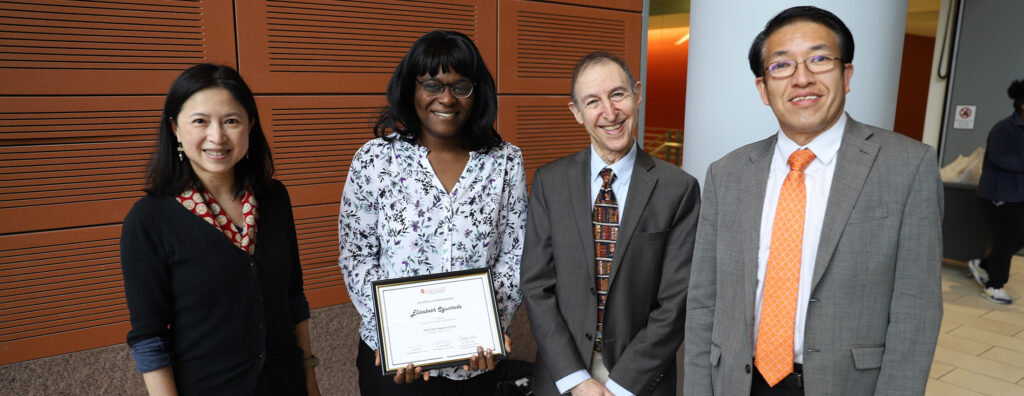
1st Place: Elizabeth Oguntade, PhD student in Bioengineering.
On-Demand Activation of Functional Protein Surface Patterns with Tunable Topography
Suitable for Biomedical Applications. Advisor: Dr. James Henderson
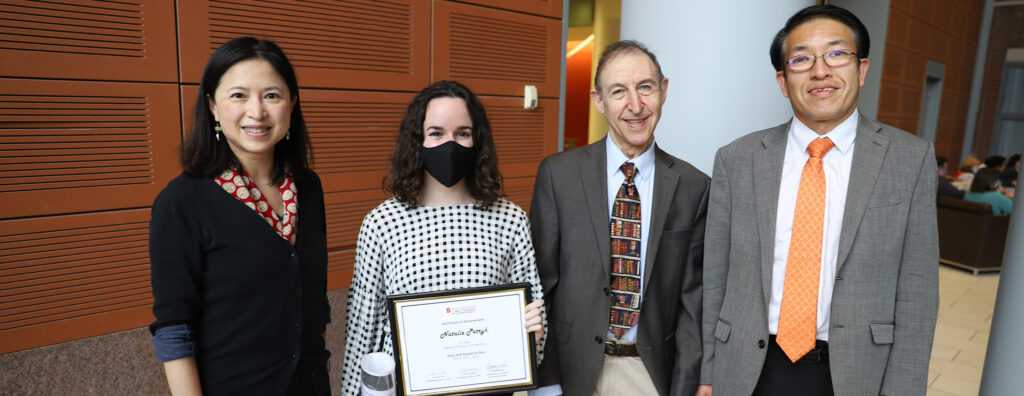
2nd Place: Natalie Petryk, MS student in Bioengineering.
Synthesis of Shape Memory Polymer Foams with Off-the-Shelf Components for Improved
Commercialization. Advisor: Dr. Mary Beth Monroe

3rd Place: Alexander Hartwell, PhD student in Mechanical and Aerospace
Engineering.
Introduction of a Multilayered Cathode for Improved Internal
Cathode Tubular Solid Oxide Fuel Cell Performance. Advisor: Dr. Jeongmin Ahn
Honorable Mention: Saif Khalil Elsayed, MS student in Civil Engineering.
Modeling Self-Folding Hybrid SU-8 Skin for 3D Biosensing Microstructures.
Advisor: Dr. Zhao Qin
Oral Presentation Competition
Communication and Security Session
1st Place: Kai Li, PhD student in Electrical/Computer Engineering. Detect and
Mitigate Vulnerabilities in Ethereum Transaction Pool. Advisor: Dr. Yuzhe Tang
2nd Place: Xinyi Zhou, PhD student in Computer/Information Science. “This is
Fake! Shared it by Mistake”: Assessing the Intent of Fake News Spreaders. Advisor:
Dr. Reza Zafarani
Health and Well-being Session
1st Place: Yousr Dhaouadi, PhD student in Chemical Engineering. Forming
Bacterial Persisters with Light. Advisor: Dr. Dacheng Ren
2nd Place: Henry Beaman, PhD student in Bioengineering. Gas-Blown Super
Porous Hydrogels with Rapid Gelling and High Cell Viability for Cell Encapsulation.
Advisor: Dr. Mary Beth Monroe
Energy, Environment & Smart Materials Session
1st Place: Durgesh Ranjan, PhD student in Mechanical and Aerospace Engineering.
Porous nanochannel wicks based solar vapor generation device. Advisor: Dr.
Shalabh Maroo
2nd Place: Alexander Johnson, PhD student in Civil Engineering. Estimating Dry
Deposition of Atmospheric Particles by Rain Washoff from Urban Surfaces.
Advisor: Dr. Cliff Davidson
Sensors, Robotics & Smart Systems Session
1st Place: Lin Zhang, PhD student in Computer/Information Science. Adaptive
Sensor Attack Detection for Cyber-Physical Systems. Advisor: Dr. Fanxin Kong
2nd Place: Zixin Jiang, PhD student in Mechanical and Aerospace Engineering,
Short-term occupancy prediction driven intelligent HVAC control. Advisor: Dr. Bing
Dong
Biomedical and Chemical Engineering Professor Lawrence Tavlarides Retires After Remarkable Academic and Research Career
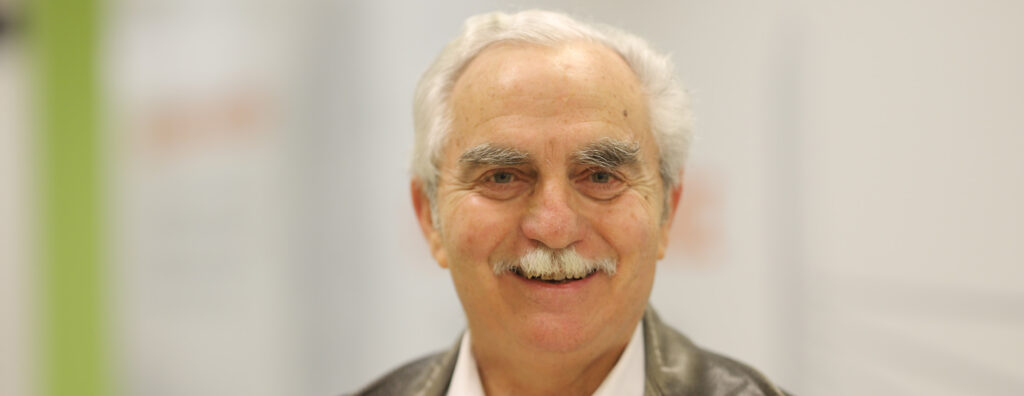
After 40 incredible years at Syracuse University, biomedical and chemical engineering Professor Lawrence Tavlarides will retire at the end of the Fall 2021 semester. Tavlarides received his BS, MS and Ph.D. degrees at the University of Pittsburgh in the 1960s. After working several years at Gulf Research and Development Center as a research engineer in Pennsylvania and completing his academic studies at the University of Pittsburgh he went through the academic professional ranks at Illinois Institute of Technology for the 12 years from 1969 – 1981. Tavlarides then joined Syracuse University in September 1981 as the chairman of the then chemical engineering and material science department for four years and has continued as a professor. He has received numerous honors and recognitions for contributions to the chemical engineering profession, academia and society. Tavlarides has taught numerous courses in chemical engineering, nuclear engineering and biochemical engineering. He has supervised 45 masters of science students ( 31 at SU ), 34 doctoral students (23 at SU), and 13 post-doctoral associates at SU over his career. His contributions with students and colleagues to research includes 1 book, 18 patents, 163 research publications , 2 educational publications and over 300 presentations at technical meetings and Universities. He was principle investigator of 70 research grants ( 53 at SU) over his career. Tavlarides was also a member of numerous committees on treatment of nuclear wastes for the US Department of Energy and Nuclear Regulatory Commission in the first decade of 2000. He is proud to complete his career at Syracuse University.
